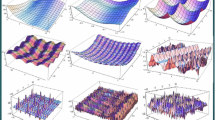Abstract
Nonlinear optimizers often report infeasibility during the process of initial construction of a model, or alterations to an existing model. Because solvers are unable to decide feasibility of a nonlinear constraint set with perfect accuracy, there are numerous possible explanations: the physical model really is infeasible, there is an error in the nonlinear constraint set causing infeasibility, or the model is feasible but the initial point or solver parameters are poorly chosen. It is difficult to proceed to a diagnosis of the problem in a large NLP.
This paper presents an algorithm providing automated assistance in analyzing infeasible NLPs. The deletion filtering algorithm isolates a Minimal Intractable Subsystem (MIS) of constraints, a minimal set of constraints which appears infeasible to the solver given a specified initial point and parameter settings. The MIS may be as small as a few constraints from among the very much larger set defining the original model, and helps to focus the examination, thereby speeding the diagnosis. A computer tool embodying the algorithm, LSGRG (MIS), is developed and applied to demonstration examples.
Similar content being viewed by others
References
J.W. Chinneck, “MINOS(IIS): Infeasibility Analysis Using MINOS,” Computers and Operations Research, vol. 21, no. 1, pp. 1–9, 1994.
J.W. Chinneck and E.W. Dravnieks, “Locating Minimal Infeasible Constraint Sets in Linear Programs,” ORSA Journal on Computing, vol. 3, no. 2, pp. 157–168, 1991.
C.J. Debrosse and A.W. Westerberg, “A Feasible-Point Algorithm for Structural Design Systems in Chemical Engineering,” AIChE Journal, vol. 19, no. 2, pp. 251–258, 1973.
J. Gleeson and J. Ryan, “Identifying Minimal Infeasible Subsystems of Inequalities,” ORSA Journal on Computing, vol. 2, no. 1, pp. 61–63, 1990.
H.J. Greenberg, “An Empirical Analysis of Infeasibility Diagnosis for Instances of Linear Programming Blending Models,” IMA Journal on Mathematics in Business, to appear, 1992.
D.M. Himmelblau, Applied Nonlinear Programming, McGraw-Hill Book Company, 1972.
B.A. Murtagh and M.A. Saunders, MINOS 5.1 User's Guide, Technical Report SOL-83-20R, Systems Optimization Laboratory, Department of Operations Research, Stanford University, 1987.
S. Smith and L. Lasdon, “Solving Large Sparse Nonlinear Programs Using GRG,” ORSA Journal on Computing, vol. 4, no. 1, pp. 2–15, 1992.
J. van Loon, “Irreducibly Inconsistent Systems of Linear Inequalities,” European Journal of Operational Research, vol. 8, pp. 283–288, 1981.
Author information
Authors and Affiliations
Rights and permissions
About this article
Cite this article
Chinneck, J.W. Analyzing infeasible nonlinear programs. Comput Optim Applic 4, 167–179 (1995). https://doi.org/10.1007/BF01302895
Received:
Revised:
Issue Date:
DOI: https://doi.org/10.1007/BF01302895




